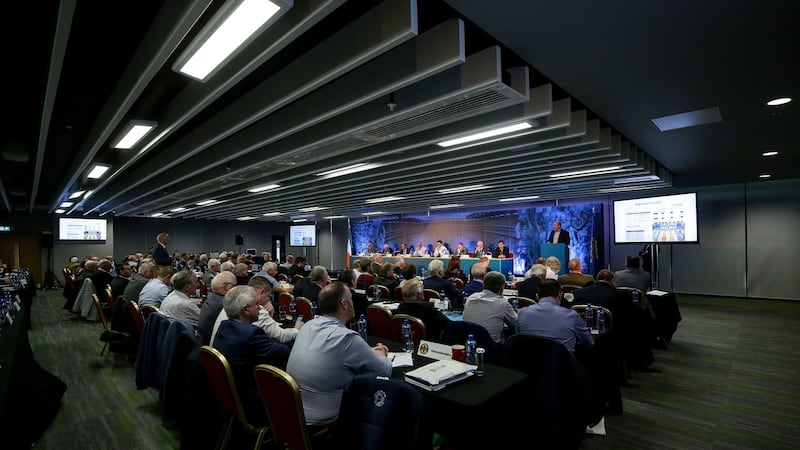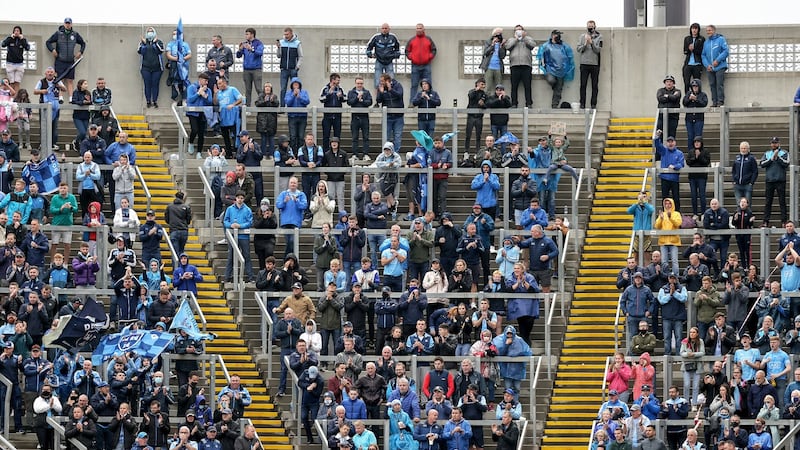Nature has healed. Don’t mind all the yakadoodling about nightclubs and live gigs and all that carry-on. The GAA has a Special Congress today and there will be real, actual, live people at it. No Zoom, no streaming, no fiddling around with dodgy connections. Just 183 delegates in a room plus a few handlers, press and sundry hangers-on.
Given that the vote on championship structures looks to have tightened through the week, the actual corporeal presence of the delegates may not be insignificant. Half the fun - for want of a better phrase - of Congress is the arm-twisting that goes on ahead of a major vote. Many’s the mind was made up down the years over a pint in the corner of a hotel bar late on a Friday night.
“You’d see it especially when there’s the election of a president at stake,” says one current county chairman. “There’d be a lot of positioning going on, not just for the election that is at hand but for the next one down the road as well. The next lad would be manoeuvring himself into position and you would see plenty of promises being made about getting on this committee or that one.
“It’s one of the big problems with the GAA, in all honesty. There’s a layer of guys who are too old and disconnected. They’re more interested in their political career and more concerned about getting themselves into position. The wheeling and dealing that goes on feeds into it all.”
The reason any of this matters at all is that by nightfall, the football championship may or may not have undergone only its third fundamental overhaul in 135 years. The people charged with either bringing about this change or hedging their bets and pushing it into next year head to Croke Park with a month’s politicking already under their belt. Most votes at Congress, special or otherwise, are forgotten before teatime. This is one of those that has the potential to echo down the decades.
Most people know the drill by now. Two options sit on the clár, devised by a group called the Fixtures Calendar Taskforce in the autumn of 2019. The first has no hope of being passed and looks likely to be withdrawn. The second has the backing of the association’s president, its director general, the GPA and some - but by no means all - counties. The motion needs 60 per cent of the vote to pass and the big unknowns going into the weekend are where the overseas votes will go.
Crucial problem
At any rate, the one thing everyone appears to agree on is the need for change. Championship structures are at once the most nauseatingly dull subject in all of GAA discussion and also a perennially crucial problem in need of a fix. Nothing encapsulates this better than the fact that even those voting against change this weekend wouldn’t dream of defending the status quo.

Nobody wants what they currently have yet it’s entirely possible that they will continue with it, simply because they can’t get agreement on doing something different. This is a very GAA way of doing things. There is every chance, in fact, that they knock it back this time around before adopting it wholesale at a later date. This is also a very GAA way of doing things.
We’re not that far removed, after all, from the 2016 Congress where a motion to move the All-Ireland hurling final to August and the football final to the first week of September was defeated, only for the self-same motion to be passed the following year. And within three years of that, it became a slam dunk no-brainer that the All-Irelands would all be done by the end of July. GAA change tends to follow Hemmingway’s line about how you go bankrupt. Gradually, then all at once.
So we can be certain on some level that the football championship will have a Dermot Bannon-style transformation wrought upon it at some stage in the not-too distant future. The conversations around it in the past few weeks have been interesting, not so much for what they’ve included but more for what they’ve left out. As has been said, everyone seems to agree on the need for change. But nailing down the exact reasons why has been a slippier thing.
Partly, it’s boredom. The All-Ireland final has been competed in by only five different counties in the past decade. The same four counties have filled the semi-final spots in five of the last nine seasons. The championship has never funnelled this small a coterie of teams into its business end for such a sustained period of time. The mood for change is driven, therefore, by a sense that something else must be provided for everybody else. Which is fair enough. Laudable, in fact.
But those of us who argue for change can’t be coy about it either. Part of the drive for change is a desire to see the best teams playing against each other more often at the business end of the season. We look at the hurling championship with its rip-roaring provincial round-robins and we think life would be good if football had some of that.
Increasingly though, it has felt like we are having the wrong conversation. The hurling championship works because when it comes right down to it, hurling people have always been happy to silo off the best counties and let them fight for Liam MacCarthy amongst themselves. The distance back to the other counties is unbridgeable but beyond a tiny knuckle of hurling folk labouring in saltmines around the place, not enough people care that this is the case.
Unprecedented distance
So the comparison with football falls down because the current distance between the top counties and the rest hasn’t historically been as huge as it is right now. You can be in your 20s and still remember a time when Dublin went seven years without even winning a Leinster championship. A couple of the Down players who got completely annihilated by a half-paced Donegal this summer have played in more All-Ireland finals than most of the team that beat them.
Football is used to teams bubbling up and falling away. Yet we’re living in a period of unprecedented distance. Not just between the top and the bottom but between the top and the next-to-the-top. The idea that changing the championship structures is going to fix this is a nice one. But it seems a bit simplistic. A bit cross-your-fingers and hope that everyone enjoys the big games enough not to notice it hasn’t changed things.

Notably absent from all the conversations around this Special Congress has been any real interrogation of why this distance between the top and the rest exists. It does seem like an opportunity missed, for example, that in the move to a league-based championship, no move was made to change back to the old 1A/1B and 2A/2B model.
This would have eight teams in 1A, made up of four each from Division One and Two. Ditto the eight in 1B, and so on down the line. At a stroke, the inbuilt advantage the dominant counties have each year is diminished.
Dublin, Kerry, Mayo and Tyrone improve every year at least in part because they play each other every year. It only stands to reason that over time, the same ought to be true of the likes of Kildare, Roscommon, Cork, Meath, Clare and the rest of that middle tier. That’s how it was up until 2007 when they changed to a straight four-tier league. And look what has happened since.
It is screamingly obvious that the hothousing of the Division One teams in the same pool over the past 15 years has strengthened them and weakened everyone else. If one of the reasons behind the move to a league-based championship is an attempt to restore competitive balance - and the taskforce’s report specifically cites that as one of its aims - then surely this was a simple way of making a start.
The other great unmentionable, of course, is money. Arguably no factor looms as large over the imbalance in the football championship as the finance that goes into the preparation of teams and yet it didn’t play the slightest part anywhere in the restructuring debate. This despite the fact that if it passes, the new format will automatically make the top counties far more attractive to sponsors by dint of the simple fact that they will be playing each other in massive games in the summer.
Just this week, Dublin launched a new second jersey. The same Dublin who already sell, according to a 2016 report, 20 per cent of all GAA jerseys in the country annually - somewhere in the region of 30,000 of them. The same Dublin who already sell around 100,000 pieces of kit - jackets, hoodies, gilets, etc - every year. In general, it is O’Neill’s who make the bulk of the money from jersey sales but it goes without saying that Dublin are far better positioned to make commercially attractive deals in this space than anyone else.
Pooled sponsorship
Dublin’s advantage in this regard is baked in because population, support base, history, yadda, yadda, yadda. Yet everyone accepts the fact that they have it, just as Mayo and Kerry do to a lesser extent, and so on, all the way down. The idea of pooled sponsorship gets mentioned in dispatches from time to time but never altogether seriously. Yet in terms of contribution to competitive imbalance, it surely has at least as serious an effect as the championship format.
“They have to listen to the players on this one,” says the county chairman quoted at the top of the piece. “We sat down with our players last week and they’re totally in favour of changing it. I don’t get the feeling that it’s the preferred policy of the powers that be but the players want this. They want to have something to play for. This isn’t the icing on the cake but it’s better than what’s there.”
All of which is undoubtedly the case. A league-based championship will be a lot of fun. A properly-treated Tailteann Cup - with an All Stars scheme and a team holiday and, crucially, the same billing as the All-Ireland final - has a good chance of working too. But through it all, the original sin of an imbalanced funding model will still be there.
The structural problems in football go deeper than the tournament format. Until there’s a special congress addressing that, everything else feels like tinkering around the edges.




















